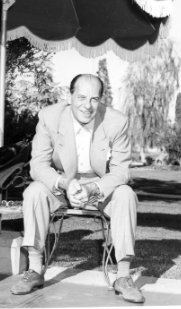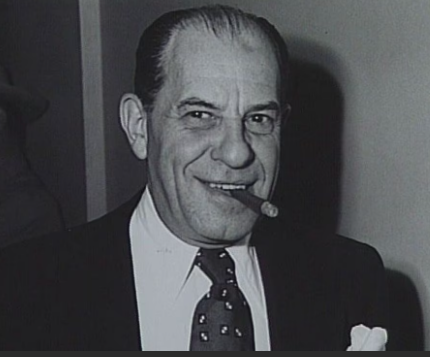In the sunbaked streets of 1950s Phoenix, a white Cadillac purred through quiet neighborhoods, its tail fins glinting in the streetlights. Inside, Bess Greenbaum drove her housemaid home like she did every night. She didn’t know it then, but death was already waiting for her at 1115 W. Monte Vista Road. Within hours, Bess and her husband, Gus Greenbaum—once one of the most powerful men in Las Vegas—would lie butchered in their home. The mob doesn’t leave retirement packages. Just blood and silence.
Gustave “Gus” Greenbaum was born in Chicago on February 26, 1893, the son of Jewish immigrants who had clawed their way from Eastern Europe to the grit and grind of America. From those hardscrabble beginnings, Gus rose not through hard work and hope—but through blood, vice, and unflinching loyalty to the underworld.
He came up alongside Meyer Lansky on New York’s Lower East Side in the 1910s. The streets were a brutal classroom, and Greenbaum was an attentive student. Prohibition turned street punks into millionaires, and Gus found his niche with the Chicago Outfit. By 1928, he was running the Southwest arm of the Trans-America wire service from a Phoenix office in the Luhrs Tower. His reach stretched across Arizona’s desert cities, and he was whispered about in the same breath as the nation’s most feared gangsters.
Greenbaum was a man who wore silk pajamas and steel underneath. He cultivated politicians, allegedly including a young Barry Goldwater, and transformed dusty Phoenix into an operational hub for the Outfit. He didn’t need muscle—he had charm, brains, and numbers that always added up. But when World War II ended, the mob turned its gaze west—to Las Vegas.

In the mid-1940s, Gus and his associate Moe Sedway took the reins of the El Cortez Casino. The city was barely more than a neon-lit frontier town. But then came Bugsy Siegel and the Flamingo Hotel—an opulent desert palace where mob money met Hollywood glamour. Siegel’s dream was bold, brilliant… and bleeding money. He skimmed from the wrong pockets, and in June 1947, he paid the ultimate price—nine bullets through the window of his girlfriend’s Beverly Hills home.
With Siegel’s brains on the wall, the Flamingo was in free fall. Enter Gus Greenbaum.

Under Greenbaum’s steady, calculating control, the casino turned around almost overnight. He stabilized the hemorrhaging books, paid off debts, and turned the Flamingo into a golden goose. He wasn’t flashy like Bugsy. He didn’t need to be. He was the quiet accountant of the Syndicate, the man who kept things profitable and orderly—until he didn’t.
As Greenbaum’s power grew, so did his demons. He returned to Phoenix in the early 1950s, hoping to retire. But when he turned down an offer from Chicago boss Tony Accardo to run the Riviera in Las Vegas, his sister-in-law turned up dead. Message received. Gus took the job.
By the mid-1950s, Greenbaum was running multiple casinos, handling millions in mob money. But he was unraveling—gambling, drinking, chasing women, and worse. He started skimming off the skim. The Chicago Outfit, ever vigilant, took notice.
And then came December 3, 1958.
Earlier that evening, everything seemed normal. Bess Greenbaum dropped off the maid, Pearl Ray, in the Cadillac. When Pearl returned the next day, she found the frozen food still on the counter. Something was wrong.
Inside the Greenbaum home, the scene was savage. Bess lay face down on a divan, wrists tied with a cheap necktie, her skull crushed with a decorative bottle, her throat slashed with a nine-inch butcher knife. Pillows were placed beside her head—to stifle her screams or to keep the blood off the furniture. The killer had used a cellophane bag to grip the knife. No fingerprints. No forced entry.
Gus was found sprawled across the twin beds in the master bedroom, the TV still humming. His throat was nearly severed. His silk pajamas were soaked in blood. He’d been struck hard in the head—twice. Two thousand dollars was missing, along with a three-carat diamond ring. Oddly, his expensive watch was untouched. A message, not a robbery.
The murder sent shockwaves through Las Vegas, Phoenix, and Chicago. This was no ordinary hit. It was theatrical, symbolic—almost ritualistic. Yet some law enforcement officials dismissed the mob connection.
“It was too messy,” Nevada Gaming Control Board Chairman Robbins Cahill said. “It looked like a crime of passion.” Maybe. But who slaughters a man and his wife with their own butcher knife, pads the crime scene with towels and newspapers, and walks out without leaving a trace?
One suspect briefly emerged—Milner Jarvis, a former Flamingo hotel clerk who had once stolen $45,000 from Greenbaum in 1948. Jarvis had just resurfaced in Las Vegas. But there was no hard evidence.
Even the U.S. Justice Department stepped in, convening a federal grand jury to probe the slayings and broader mob activity in California and Arizona. Joseph Bonanno, a titan of the American Mafia based in Tucson, was subpoenaed. So were others who had attended the infamous Apalachin Mafia summit just a year before. But nothing stuck.
Greenbaum’s murder has never been solved. No one was charged. No one confessed.
In the end, Gus Greenbaum’s legacy is cemented not in a monument, but in pop culture. His name was fused with Moe Sedway’s to create Moe Greene, the flamboyant casino boss in The Godfather, gunned down with a bullet to the eye. But Gus’s real death was far more brutal. It was the price of betrayal. The penalty for weakness. The final chapter in a gangster’s life written in blood and silence.
They say you don’t leave the mob. You only get retired. Gus Greenbaum didn’t retire in peace. He retired with a butcher knife in his throat, a pillow over his head, and the television still on—just another quiet night in the desert gone deadly.
Welcome to the house edge of the underworld. Where the odds are rigged, and everyone pays in the end.
Authored by C.F. Marciano – Where Every Word Hits Like a Deal You Can’t Refuse


